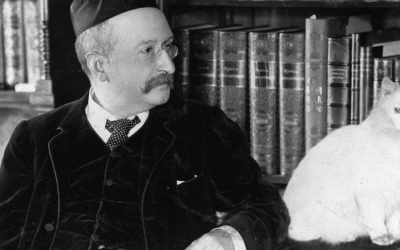Russell Blackford looks at the conceptual foundations of a new intellectual movement.
Technology has given us tools to manipulate the world around us. In such forms as telescopes and microscopes, it has augmented our perceptual capacities and opened up the universe to our inspection on new scales. Technologies such as writing and computers have even extended our minds and memories. As we learn to handle tools and machines, we alter our neurological pathways in what can be seen as a kind of cyborgisation.
Nonetheless, much remains the same. The underlying capacities of contemporary people are not so different from those of early Homo sapiens. In principle, technology can do much more to change us.
We have reached a point in history where there are realistic prospects of boosting our cognitive, emotional, perceptual, and physical capacities through deliberate and increasingly direct technological interventions. These might be, for example, genetic (modifying human DNA), prosthetic (incorporating tools or machines into our bodies), or pharmaceutical (fine-tuning our bodies with drugs to be smarter, stronger, happier, or longer-lived). Even if it is too late to employ these technologies to alter ourselves, it might not be too late for our children or our grandchildren. New technologies would, of course, be added to more familiar ones that can already be understood as enhancing human capacities, rather than as ‘merely’ therapeutic. Consider, for example, vaccinations for enhanced immune responses, the contraceptive pill to control female fertility, cosmetic surgery to ‘improve’ (whatever that means in this context) physical appearance, and anabolic steroids to help build muscle mass. Even rather innocuous substances such as coffee can be thought of as enhancement technologies, not to mention more powerful (and often illegal) drugs that can alter the moods and perceptions of healthy people.
Even as it becomes more familiar, the idea of technologically enhancing human capacities inspires much anxiety. Often, indeed, it generates social and political opposition – fierce enough to have procured numerous legal prohibitions on genetic tampering with human embryos. These have been enacted in recent decades by many countries at quite varied stages of industrial development.
Much of the anxiety is probably irrational, based on poorly articulated intuitions about playing God, violating nature, disrespecting human dignity, or ushering in a scary future with bizarre social arrangements. In other cases, however, the arguments have greater claims to our rational consideration. Some of the mooted technologies might be difficult to achieve, and the attempt might distract us from more important problems. Others might be all-too-achievable, but dangerous or open to abuse. Critics often present us with the spectre of a caste society divided into a highly enhanced ruling class (based largely on family wealth) and a more ‘natural’ population of subordinates with less ready access to the new technologies. The possibilities for oppression and suffering are fairly obvious. Whether such an outcome would ever occur in practice, it is at least difficult to rule out.
There is much to be said, pro and con, about whether we should welcome a future of technologically driven enhancement of human capacities. Many politicians, academics, church leaders, and lobby groups are passionately resistant to the very idea of human enhancement, but one intellectual and cultural movement embraces the idea with all its arms. I’m referring, of course, to transhumanism.
Transhumanist views have a long history, although the contemporary transhumanist movement is a product of twentieth-century advances in scientific understanding and technological capability. Precursors can be found, for example, in the futurist speculations of J B S Haldane and J D Bernal in the 1920s. Haldane’s Daedalus; or, Science and the Future (1924) and Bernal’s The World, the Flesh and the Devil (1929) envisage future societies that employ advanced science to alter human traits and direct our future evolution as a species. In the following decades, these writings were highly influential on science-fiction authors – perhaps most notably Olaf Stapledon and Arthur C Clarke – but they also produced a backlash, as in Aldous Huxley’s Brave New World (1932), much of the work of C S Lewis, and a veritable ocean of dystopian fiction and cinema.
Ideas such as Bernal’s and Haldane’s provide a continuing undercurrent in twentieth-century thought. However, transhumanism as a consciously organised movement took shape only in the 1970s and 1980s, with much of the early ferment happening in the high-tech enclaves of America’s west coast. Early transhumanist thinker F M Esfandiary published his UpWingers: A Futurist Manifesto in 1973. Shortly thereafter, he changed his legal name to FM-2030 partly in anticipation of his hundredth birthday in 2030 (he actually died in 2000, and his body was placed in cryonic suspension). He lectured at the University of California, Los Angeles, and in 1989 published his influential book Are You a Transhuman? During the 1980s, FM-2030 and others developed transhumanism as a visionary movement with outreach into philosophy, science, and the arts.
Most recently, long-time advocates of transhumanism Max More and Natasha Vita-More have published The Transhumanist Reader, a large volume of older, newer, and freshly commissioned essays that explore transhumanism’s ideals and ideas. It includes contributions by many of the philosophers, scientists, artists, creative writers, and others who have been closely associated with transhumanism over the past three decades.
What, then, is transhumanism when you boil it all down? In its current form, it is a broad movement – not so much a philosophy as a class of philosophical claims and cultural practices. As The Transhumanist Reader amply demonstrates transhumanism is lively with internal debates. Still, it has a discernible core of ideas. One is that of human beings in transition: this word puts the ‘trans’ in ‘transhumanism’ and ‘transhumanist’. Transhumanists sometimes speak of transcendence or of transformations, but the idea of a transition is crucial. Transition, then, from what to what?
Transhumanists foresee a time when technological interventions in the capacities of the human body and mind will lead to extreme alterations in our capacities. For fully-fledged transhumanist thinkers, these alterations will be so dramatic that it makes intuitive sense to think of the deeply-altered people of the future as posthuman (adjective) or posthumans (noun). Posthumans, so it is theorised, will be continuous with us but unlike us in many ways. In particular, they will live far longer lives than ordinary human beings, and they will be happier and cleverer. An extreme variation on this idea is that we might upload our personalities into advanced and highly durable computer hardware, interfacing with the world in complex ways.
Optimistically, you and I might become posthuman one day, if we just live long enough, but more likely the posthumans could be our children or our grandchildren. Given this picture, we are not posthuman yet, and perhaps it makes little sense to call ourselves ‘transhumans’. Still, so the argument goes, Homo sapiens has reached a point in technological development where the current generations of human beings form a bridge between historical humans and future people with greatly superior capacities. For transhumanists, this may not be inevitable – a point that I’ll return to – but it is a logical progression of past and current trends.
Transhumanism adds one more core idea: the idea that the transition from human to posthuman is essentially desirable. More generally, it is desirable to increase our capacities, including the span of human life, through whatever means are available, including direct technological interventions in the functioning of our bodies. Transhumanists pursue their aims through technological innovation, personal practice, artistic expression, and advocacy in the public square. Note, however, that there is no body of doctrines subscribed to by the movement as a whole. Transhumanist thinkers come with many analyses, priorities, and ideas, and they frequently disagree with each other about specific goals and the most effective methods for achieving them.
Earlier, I called transhumanism a philosophical and cultural movement, but is it really something more like a religion or an apocalyptic cult? Alternatively, should we see it as merely a bizarre fad that has spun off from the science-fiction and IT communities of California?
First, it is worth noting that, whatever else it might be, transhumanism is not an unworldly belief system. Nothing supernatural is involved, and any transformations that take place will be produced by purely this-worldly means. If there is anything that tranhumanists want to transcend, it is the current limits on human capacities, not the natural world itself.
Transhumanism does not invoke any being, entity, or force that transcends the natural world, and nor does it postulate otherworldly dimensions to human (or posthuman) flourishing. Although it imagines us changing in various ways, these fall within ordinary worldly desires, such as the desire for a longer life in this world. Most transhumanists would emphatically deny that transhumanism is a religious system, and they can make a strong case for that position.
At the same time, there is, indeed, something rather apocalyptic and cultish about at least some transhumanist activity and writing, particularly when we are promised a rapid transition to vastly extended life spans and a post-scarcity economy. One suggestion frequently presented in the transhumanist literature is that this will happen via something called the Singularity, a near-future event involving sudden and unprecedented technological advances. The idea is that the exponential curve of technological improvement over time is approaching a point where it will go almost vertical, leaving what lies on the other side radically beyond human prediction.
Often, this near-vertical take-off in technology is associated with the prospect of rapidly and recursively self-improving artificial intelligence of some sort. This might, in theory, lead to the appearance of cybernetic beings so cognitively superior to ourselves that they would defy human comprehension, not to mention human attempts to control them. They would possess an extraordinary ability to make further conceptual and practical advances, presumably for human betterment. If these beings ever do come into existence, let us hope that our new computer overlords turn out to be friendly!
In fact, much activity from committed transhumanists working in the field of cognitive science involves efforts to ensure that any machine super-intelligences of the future will, indeed, be benevolent in their attitudes to human beings. Some researchers are expending much time and brainpower in a quest to understand the nature of benevolence, human sympathy, and the like, and how these could ever be programmed into the deepest design levels of machine super-intelligences. Whether or not this research program, sometimes known as ‘Friendly AI’, will eventually bear fruit, it generates much interesting interdisciplinary discussion (involving moral philosophers and cognitive scientists, among others).
Transhumanists who emphasise the prospect of the Singularity envisage change on a vast scale within a very short period. However, not all transhumanists think in such an apocalyptic way, and indeed ‘Singularitarian’ ideas are rejected by many transhumanists who have less grandiose ambitions for the human future.
How seriously should we take all this? Is transhumanism merely a fad that we can dismiss? Not so quickly, I suggest. I expect that we will, indeed, discover new ways to enhance human capacities, whether or not any of them are as spectacular as mind uploading or a technological Singularity. If the science of enhancement continues for long enough, why wouldn’t it eventually produce people very different from us or our ancestors? Furthermore, I accept in a general way that enhancement of human capacities is desirable, whatever qualms we might have about the details and about important political issues such as those of distributive justice. If expressed at a sufficiently general level, the transhumanist thesis is plausible, even attractive. Or so it seems to me.
In any event, let us assume for argument’s sake that the most dramatic – some might say ‘horrific’ – visions of a posthuman future are exaggerated. All the same, something less sudden and disruptive might happen as new technologies cumulatively transform what human minds and bodies can do, probably with substantial social effects. Compare, for example, the myriad consequences of electrification, motor cars, the Pill, air transport, computers, and the Internet.
Nonetheless, this raises difficult problems, not least for philosophers. Some might challenge the very notion of ‘improvement’ or ‘enhancement’ of human capacities. Mightn’t enhanced human beings or posthumans be merely different, not better by any objective test? In which case, why go to so much trouble? Alternatively, how much change in ourselves does it make sense to want? Is a distinctly posthuman life a good one for beings who started out as human? And even if it is, can beings like us safely obtain it? Beyond certain limits, will we even be us if we undergo sufficiently extraordinary changes? Such questions encourage philosophers with an interest in transhumanism to grapple with issues relating to value theory, personal identity, and survival over time.
Transhumanist thinkers often seem keen on objective values. For example, they may think it objectively better for us to persist longer, feel happier, have increased abilities to affect the universe around us, and attain more complexity in our organised functioning. If they are correct about this, they have the beginnings of an argument that it is better to be posthuman than human – and perhaps it is better to be a human being with than one without certain technological enhancements.
Such an objectivist approach to value may seem implausible, but arguably the notion of ‘improvement’ need not rely on the idea that certain kinds of functioning are objectively better than others, independent of our current preferences. If we consider such examples as general health, disease-resistance, intelligence (perhaps understood as a broad-based problem-solving ability or a cluster of such abilities), it is always possible to imagine bizarre examples where these are detrimental. Nonetheless, they are of benefit in a vast range of situations that we encounter under many social and other conditions. It seems perfectly reasonable to prefer these things to their opposites, and to speak of improving them.
There might still be a question as to whether there could be too much of a good thing: might we prefer a longer but not vastly longer span of life, for example? And as I suggested, there is a question as to what conditions are required for us to preserve our identities at all. If I lived for thousands of years, would a time come when I could no longer be considered the person I am now? Or should this be seen much as we currently view growing up? I am very different from the child I was at, say, the age of four, and I retain few memories from that age. Yet we do not deny that the child has survived as the much older person I am now.
We might also wonder whether transhumanists are naïve about technology, human nature, and the idea of progress. Technology can be used for deliberately destructive purposes, and it can have unforeseen and unwanted effects; human nature has its dark side; and we cannot assume in the manner of Whig historians that things are always getting better. Indeed, the results of climate change, overpopulation, and depletion of natural resources could combine to offer humanity a very bleak future indeed.
However, transhumanists need not be naïve about any of this. The central transhumanist ideas do not rule out that things could go wrong, and cautionary points can be advanced within the transhumanist movement as well as by its critics. Indeed, much recent transhumanist thought has a surprisingly dystopian tinge, as the authors concerned contemplate what might go very wrong, perhaps preventing any posthuman transition from taking place after all, and perhaps threatening human civilization or human life itself. Thus, one focus of current transhumanist thought relates to existential risks – what could go very wrong on a global scale, and what might be done in an attempt to prevent it.
My own concern about the transhumanist movement is not any of the above. Many transhumanist ideas will doubtless prove impractical, but others may come to fruition. Meanwhile, the discussions are challenging and exciting; there is much scope within the movement for brainstorming, arguments, and new ideas. At its best, transhumanism is far more valuable than a fad or a cult, but there is always the danger that it could rigidify.
Given its vision of a highly desirable future for humanity (and whatever takes humanity’s place), the transhumanist movement has at least some potential to develop into a fanatical, even apocalyptic ideology. As I observe in my own contribution to More and Vita-More’s collection, no one has ever been imprisoned, sterilised, starved, or burned to do in the name of transhumanism; nonetheless, there is a risk of transhumanism developing into something dogmatic, illiberal, even downright nasty. The greatest danger is if a particular vision for the future hardens into a new orthodoxy. This can be avoided, but only with self-awareness and self-scrutiny. That, I think, is an ongoing challenge for transhumanist thinkers.
RUSSELL BLACKFORD IS A CONJOINT LECTURER IN THE SCHOOL OF HUMANITIES AND SOCIAL SCIENCE, UNIVERSITY OF NEWCASTLE, NSW. HE IS THE AUTHOR OF 50 GREAT MYTHS ABOUT ATHEISM (WITH UDO SCHUKLENK; WILEY-BLACKWELL) AND HUMANITY ENHANCED (MIT PRESS).
{fastsocialshare}





